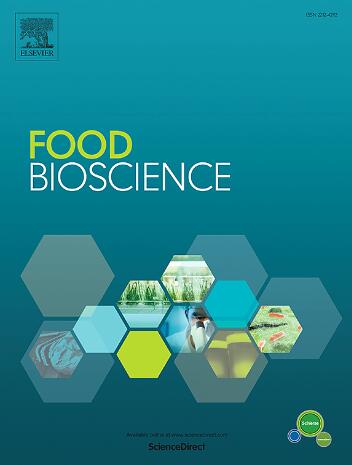由大麦自组装肽包封的燕麦酰胺- c口服可减少高脂肪饮食引起的脑氧化应激和炎症
IF 4.8
1区 农林科学
Q1 FOOD SCIENCE & TECHNOLOGY
引用次数: 0
摘要
燕麦酰胺- c (AVN-C)是一种从燕麦中提取的酚类化合物,具有抗氧化、抗炎、神经保护等多种生物活性。然而,由于AVN-C在胃肠道中的水溶性和稳定性较差,其生物利用度较低,限制了其应用。本研究以大麦自组装肽为载体,以纳米粒子的形式负载AVN-C,提高其稳定性和生物利用度。结果表明,在胃肠道消化过程中,AVN-C纳米颗粒的生物可及性接近50%,而游离AVN-C的生物可及性低于10%,药代动力学研究表明,负载AVN-C纳米颗粒的Cmax和曲线下面积(AUC)约为游离AVN-C的3倍,表明其生物利用度显著提高。值得注意的是,Tmax从30 min变为45 min,表明载avn - c的纳米颗粒具有缓释作用。此外,通过高脂饮食(HFD)诱导小鼠,研究了负载avn - c纳米颗粒的脑递送效果。结果表明,载avn - c纳米颗粒可抑制HFD小鼠脑内氧化应激,抑制炎症因子TNF-α和IL-1β的表达。转录组学分析表明,传递纳米颗粒后基因表达谱发生了改变。综上所述,大麦自组装肽形成的纳米颗粒提高了AVN-C的体内稳定性和生物利用度,促进了其生物活性的发挥。本文章由计算机程序翻译,如有差异,请以英文原文为准。

The oral delivery of avenanthramide-C encapsulated by barley self-assembly peptides reduces high-fat diet-induced brain oxidative stress and inflammation
Avenanthramide-C (AVN-C) is a phenolic compound derived from oats with numerous biological activities, such as anti-oxidant, anti-inflammation, neuroprotection, etc. However, the bioavailability of AVN-C is low due to poor water solubility and stability in the gastrointestinal tract, which restricts its application. In this study, the barley self-assembly peptides were employed to load AVN-C to improve its stability and bioavailability as the form of nanoparticles. The results showed that the bioaccessibility of AVN-C in nanoparticles reached nearly 50%, while that of the free AVN-C was less than 10% during gastrointestinal digestion, and the pharmacokinetic studies indicated that the Cmax and area under curve (AUC) of AVN-C-loaded nanoparticles were about 3 times as free AVN-C, indicating a significantly increased bioavailability. Notably, the Tmax changed from 30 min to 45 min, indicating a sustained release of the AVN-C-loaded nanoparticles. Moreover, the brain delivery effects of AVN-C-loaded nanoparticles were determined by using high-fat diet (HFD)-induced mice. The results showed that the AVN-C-loaded nanoparticles could suppress oxidative stress and inhibit the expression of inflammatory factors, TNF-α and IL-1β, in the HFD mice brain. Transcriptomic analysis indicated an alteration of gene expression profiles after the delivery of nanoparticles. In a word, the nanoparticles formed by barley self-assembling peptides improved the in vivo stability and bioavailability of AVN-C and facilitated the exertion of its biological activity.
求助全文
通过发布文献求助,成功后即可免费获取论文全文。
去求助
来源期刊

Food Bioscience
Biochemistry, Genetics and Molecular Biology-Biochemistry
CiteScore
6.40
自引率
5.80%
发文量
671
审稿时长
27 days
期刊介绍:
Food Bioscience is a peer-reviewed journal that aims to provide a forum for recent developments in the field of bio-related food research. The journal focuses on both fundamental and applied research worldwide, with special attention to ethnic and cultural aspects of food bioresearch.
 求助内容:
求助内容: 应助结果提醒方式:
应助结果提醒方式:


